|
|
| |
|
 |
Cosmetic Dentistry: |
|
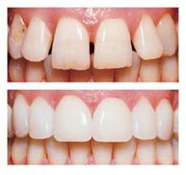 Cosmetic dentistry (smile makeovers) is the most dramatic, safest and permanent way of improving your smile and overall face structure. The effects of a smile makeover are seen way beyond teeth or the smile. It is the surest, easiest and quickest way to enhance your personality and self esteem. Cosmetic dentistry is much more than a smile makeover, it is a confidence makeover. Cosmetic dentistry (smile makeovers) is the most dramatic, safest and permanent way of improving your smile and overall face structure. The effects of a smile makeover are seen way beyond teeth or the smile. It is the surest, easiest and quickest way to enhance your personality and self esteem. Cosmetic dentistry is much more than a smile makeover, it is a confidence makeover.
|
| |
| |
| |
|
 |
Root Canal Treatment: |
|
Endodontics is the branch of dentistry that deals with diseases of the tooth's pulp. The pulp is found in the center of the tooth and in canals (called root canals) inside the root of each tooth. Pulp includes connective tissue, nerves and blood vessels. Pulp nourishes the tooth when it first emerges through the gum. Once the tooth matures, the pulp can be removed without destroying the tooth. That's because each tooth also is nourished by a blood supply in the gums.
Removing the pulp is called endodontic treatment, but it is often referred to as root canal treatment or root canal therapy. Many people refer to pulp removal as "having a root canal." Root canal treatments are quite common.
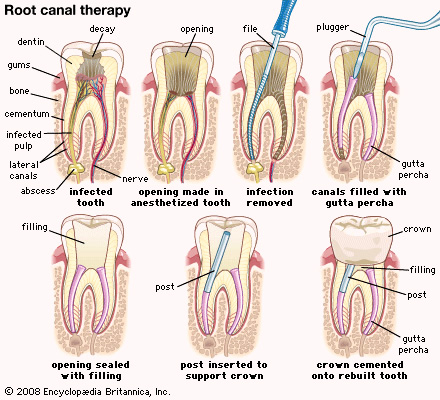 Signs and Symptoms: Signs and Symptoms:
If you have an infection of the pulp, you may not feel any pain at first. But if it is not treated, the infection will cause pain and swelling. In some cases, an abscess will form.
Your tooth might need a root canal if:
- It hurts when you bite down on it, touch it or push on it
- It is sensitive to heat
- It is sensitive to cold for more than a couple of seconds
- There is swelling near the tooth
- It is discolored (whether it hurts or not)
- It is broken
To determine whether your tooth needs root canal treatment, your dentist will often place hot or cold substances against the tooth. The purpose is to see if it is more or less sensitive than a normal tooth. He or she will examine the tissues around the tooth and gently tap on the tooth to test for symptoms.
You also will be given X-rays of the bone around the tooth. The X-rays may show a widening of the ligament that holds the tooth in place or a dark spot at the tip of the root. If either of these is present, your dentist probably will recommend a root canal procedure.
Your dentist may need more information about the tooth. He or she may use an electric pulp tester. This hand-held device sends a small electric current through the tooth. It helps your dentist decide whether the pulp is alive. This test does not cause pain or a shock. You may feel a tingling sensation. It will stop when the tester is removed from the tooth.
An electric pulp tester should not be used if you have a cardiac pacemaker or any other electronic life-support device. |
| |
| |
| |
|
 |
Crowns and Bridge: |
|
When teeth are heavily decayed they may be too weak to survive with just a filling. By placing a crown, a tooth may be given a new lease of life. Even when a single tooth is lost a denture may not be required as a bridge can be made which spans the gap with a tooth attached to those next to the space. Sometimes when a single small tooth is lost at the front of the mouth a simple bridge can be made which has 'wings' that are glued to the back of the adjacent teeth. This results in less tooth being damaged by the drill.
• Crowns:
When a tooth is heavily decayed it is more likely to fracture and lose considerable tooth substance. The greater risk is that a fracture line may go below the margin of the gum which makes restoration more difficult or near impossible.
 Crowns may be made from several different materials, gold and porcelain being the most common types. Crowns may be made from several different materials, gold and porcelain being the most common types.
Gold is usually used on the back teeth, as it has several advantages over porcelain teeth.
- Gold is strong in thin section and less tooth needs to be drilled away before taking the impression and fitting the crown.
- The lab technician finds it easier to use gold as it shrinks less when cast and is easier to polish. Crowns of porcelain shrink when cast and the technician has to estimate this when making the crown.
Porcelain is usually always used for the front teeth but may be used for the back teeth. This material can be made to appear very natural though several factors affect this and are outlined below;
Some porcelain crowns have metal inside which gives strength and support to the porcelain. This acts as a barrier for light and gives the crown a dull colour. On posterior teeth this won't be noticed but in the front of the mouth it can occasionally be a problem as the tooth looks duller than the natural teeth.
• Bridges:
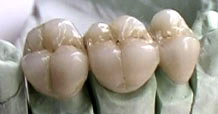 A bridge allows the dentist to replace lost teeth without the use of a denture or dental implant. Basically a false tooth is held in place by being attached to a tooth next door. The disadvantage is that the teeth next to the space have to be prepared in a similiar way to a crown in order to accept the bridge. If these teeth already have crowns or big restorations then this is not a problem, the major concern however is when these teeth have small or no restorations (fillings). One compromise is the 'acid etched bridge', with this type a fine ledge is placed on the back of the adjacent teeth. A bridge allows the dentist to replace lost teeth without the use of a denture or dental implant. Basically a false tooth is held in place by being attached to a tooth next door. The disadvantage is that the teeth next to the space have to be prepared in a similiar way to a crown in order to accept the bridge. If these teeth already have crowns or big restorations then this is not a problem, the major concern however is when these teeth have small or no restorations (fillings). One compromise is the 'acid etched bridge', with this type a fine ledge is placed on the back of the adjacent teeth.
One disadvantage of a bridge is that the patient should wait three months before placement as the 'gum' shrinks' after a tooth is extracted. If the bridge was fitted early a gap would appear underneath the pontic (the false tooth). At the back of the mouth this may not be a problem, at the front of the mouth however this may appear as a black line along the gum. |
| |
| |
| |
|
 |
Dentures: |
|
When a patient looses some or all of their teeth a denture will restore their appearance and function during speech and eating. A denture may have a metal or plastic base, usually though an upper denture will have a plastic base.
When teeth are to be extracted an immediate denture allows the teeth to be replaced on the same day as they are pulled out. A denture of this type though needs to be replaced after six months as it will become loose as the gums shrink during healing.
Types of Dentures:
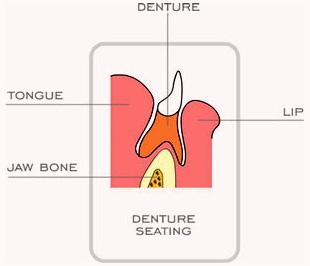 1. Full Denture: 1. Full Denture:
When the patient has no teeth in an arch the usual treatment is to provide a full denture. Many patients have difficulty adapting to full dentures as they are held in place by relatively weak forces when compared to real teeth.
2. Partial Denture:
When a patient has teeth, the dentist may construct a partial denture which fits false teeth inbetween the standing teeth.
The base of these dentures may be plastic acrylic or a metal called 'cobalt chromium'. The advantage of a plastic base is that it can easily have teeth added later. This is of particular importance with patients who have gum disease.
The metal bases allow a thinner base which is less obtrusive to the patient and also having the advantage of transmitting heat when food or drink is taken.
3. Over Denture:
When you lose teeth, the bone that supported them disappears with time. This leads to problems later as dentures may start to rock, your face may appear to become sunken and eating may become difficult.
One solution is not to extract certain teeth which are decayed, but instead to cut the crown off and root fill the root section. The tooth then acts as a support under the denture and also decreases the level of bone loss. Treatment with these dentures tends to be more expensive than a partial denture as teeth need to be root filled and small fillings placed on the top.
4. Immediates Denture:
When a patient has to have teeth taken out, a decision must be made whether the space is left empty or a artifical tooth used to fill the gap.
An immediate denture is placed in the patients mouth at the time of the extraction so that they don't need to walk around with a space which may be visible. Impressions are taken before that appointment and the lab technician has to estimate how the gum will be once the tooth is removed.
After immdiate dentures are placed they may become lose after a month or so, this is because the gum and underlying bone shrink after they heal. This produces a space under the denture which allows it to tip. The solution is for your dentist to 'reline' the denture, usually you will have to be without your denture for 24hours while it is sent back to the lab. |
| |
| |
| |
|
 |
Periodontal Treatment: |
|
Periodontal disease affects the gums and structures that support your teeth. One of the first warning signs that theres a problem is when the rim of the gums next to teeth becomes red and swollen, and bleeds easily when touched. Most often there is no discomfort at this stage, yet the disease has gained a foothold and is now known as "gingivitis." Gingivitis is reversible with improved oral hygiene techniques and a professional cleaning. Left untreated, however, the danger exists that it will progress into an irreversible periodontal 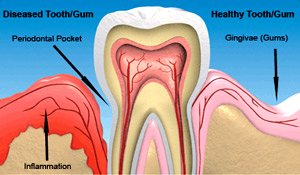 condition - periodontitis - that damages the gums and bone surrounding the teeth. condition - periodontitis - that damages the gums and bone surrounding the teeth.
Periodontitis is a more advanced disease. Bone and tissues supporting the teeth are destroyed, yet still, an individual may be unaware of the problem existing in their mouth. When this occurs, the gum attachment begins separating from the teeth, creating "pockets." These pockets harbor millions of bacteria trapped in a plaque that sticks to the teeth. Unfortunately for us, the mouth is a perfect incubator. It is warm, dark, and moist, with tons of "food" for the bacteria to metabolize. The net result is that the bacterial plaque thrives and matures.
Some individuals are more prone to periodontal disease than others. Some get a mild form, while others get a severe case. Why? It is likely we inherit a genetic predisposition to periodontal disease, and this influences how severely we will be affected by it. |
| |
| |
| |
|
 |
Dental Implants: |
|
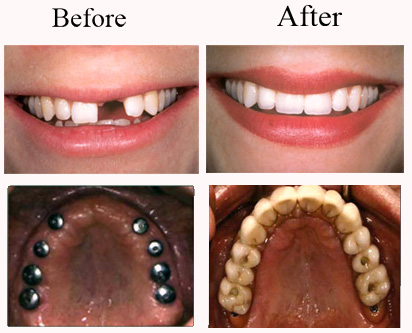 A dental implant is an artificial tooth root that a periodontist places into your jaw to hold a replacement tooth or bridge. Dental implants are an ideal option for people in good general oral health who have lost a tooth or teeth due to periodontal disease, an injury, or some other reason. A dental implant is an artificial tooth root that a periodontist places into your jaw to hold a replacement tooth or bridge. Dental implants are an ideal option for people in good general oral health who have lost a tooth or teeth due to periodontal disease, an injury, or some other reason.
While high-tech in nature, dental implants are actually more tooth-saving than traditional bridgework, since implants do not rely on neighboring teeth for support.
Dental implants are so natural-looking and feeling, you may forget you ever lost a tooth.You know that your confidence about your teeth affects how you feel about yourself, both personally and professionally. Perhaps you hide your smile because of spaces from missing teeth. Maybe your dentures don't feel secure. Perhaps you have difficulty chewing. If you are missing one or more teeth and would like to smile, speak and eat again with comfort and confidence, there is good news! Dental implants are teeth that can look and feel just like your own! Under proper conditions, such as placement by a periodontist and diligent patient maintenance, implants can last a lifetime. Long-term studies continue to show improving success rates for implants. |
| |
| |
| |
|
 |
Basic Dentistry: |
|
| This topic provides information on basic dental care. If you are looking for information on tooth decay or cavities, see the topic Tooth Decay. If you are looking for information on gum disease (periodontal disease), see the topic Gum Disease. |
| |
| |
| |
|
 |
Children Dentistry: |
|
At around 8 months of age, your child teeth will start to erupt. It is important that your child has a good diet and that sugar intake is controlled. From age 5 the adult teeth start to erupt into the mouth starting with the molar teeth. From this point it is even more important to ensure that your child has good oral health as there will be no second chances.
Good oral health can be achieved by controlling your childs sugar intake, using fluoride products and good toothpaste instruction.
Parents often have questions about how to take care of their children's teeth. When should you start brushing? What kind of toothpaste is best? When should you go to the dentist? Knowing the answers to these questions can help you keep your kids' teeth healthy and cavity free.
 Although you don't necessarily need to brush them yet, you should start cleaning your infant's teeth as soon as he gets his first tooth. At first, you can just use a wash cloth to clean your infant's teeth. As he gets more, you can use a soft children's toothbrush. Although you don't necessarily need to brush them yet, you should start cleaning your infant's teeth as soon as he gets his first tooth. At first, you can just use a wash cloth to clean your infant's teeth. As he gets more, you can use a soft children's toothbrush.
Because there is some danger if your child gets too much fluoride, your choice of toothpaste is important. Keep in mind that most brands of kids' toothpaste are fluoridated. They just have different flavors and popular characters on them to make them more fun for children, but that doesn't make it safe for your children to swallow too much of the toothpaste.
If using a fluoride toothpaste, use a small, pea-size amount of toothpaste, so that there is little danger of your child getting too much fluoride if he swallows it. And begin to encourage your child to spit out the toothpaste at a young age.
The other alternative for younger children is to use a non-fluoridated toothpaste, such as Baby Orajel Tooth and Gum Cleanser, until they are spitting the toothpaste out.
The timing of the first visit to the dentist is a little controversial. The American Academy of Pediatric Dentistry states that children should see a dentist when they get their first tooth and not later than 1 year of age. In contrast, according to the American Academy of Pediatrics, unless your child has risk factors for having problems with his teeth, such as sleeping with a cup or bottle, teeth staining, thumb sucking, etc., the first visit to the dentist should be by around the third birthday.
However, an early visit to the dentist is a good way to learn proper oral hygiene at an early age, including avoiding nighttime bottles or cups of formula or juice, proper toothbrushing, and a diet that promotes good dental health. You may also want to see a Pediatric dentist early if your child has a medical condition that puts him at risk of having dental problems, such as Down Syndrome.
Another important topic is figuring out if your child is getting enough fluoride. Children begin to need supplemental fluoride by the age of six months. If he is drinking tap water (either alone, or mixed with formula or 100% fruit juice), and you live in an area with the water is fluoridated, then he should be getting an adequate amount of fluoride. If he doesn't drink water, or is drinking well water, unfluoridated bottled water (most brands of bottled water don't have fluoride in them unless the label specifically states that they do), or filtered water, then he may not be getting enough fluoride to keep his teeth healthy. Talk with your Pediatrician or dentist about fluoride supplements.
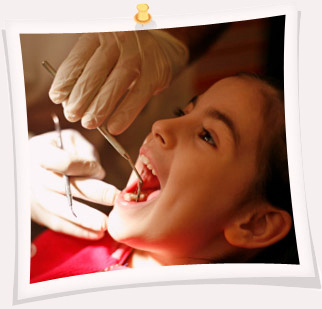 Water filters are a special concern, because some of them do filter out fluoride. Counter top filters and the pitcher type filters usually don't remove fluoride, but more sophisticated, point of use filters can. If in doubt, check with the manufacturer to see if the filter removes fluoride. Water filters are a special concern, because some of them do filter out fluoride. Counter top filters and the pitcher type filters usually don't remove fluoride, but more sophisticated, point of use filters can. If in doubt, check with the manufacturer to see if the filter removes fluoride.
You should also talk with your dentist about using sealants in your school age child. A sealant is a plastic material that is applied to the teeth, hardens, and provides a barrier against plaque and other harmful substances. Sealants can be applied to the 1st and 2nd permanent molars to help protect the grooves and pits of these teeth that can be hard to clean and are prone to developing cavities, and appropriate premolars as soon as possible after they erupt (usually after 6 years of age).
What about flossing? Flossing is an important part of good dental hygiene. You can usually begin flossing once your child is about 3-4 years old, but they likely won't be able to floss on their own until they are 8-10 years old.
In addition to teaching your children the importance of regular brushing and flossing, routine visits to the dentist and a healthy diet, it is important that you set a good example by also practicing good dental hygiene. If you do not brush and floss each day or regularly see a dentist, then it is unlikely that your children will either.
|
| |
| |
| |
|
 |
Orthodontic Treatment: |
|
Many people have crooked teeth but this can be corrected by a visit to the orthodontist. After assessing the teeth they may use various types of wires and removal blocks to alter the patients bite. When teeth are crowded, the orthodontist may decide that teeth need to be extracted to make enough room for a nice smile. The treatment can be long though and may take several years or more.
A crowded mouth can result in a loss of confidence due to cosmetic reasons and also potential damage to the teeth from wear or gum recession. When teeth are crowded they may overlap or not form a level line with the eyes. When the teeth overlap they collect plaque much more easily as the toothbrush may skip over the gaps while brushing. In the lower arch the incisors may be pushed forwards so that only half the tooth is imbedded in bone.
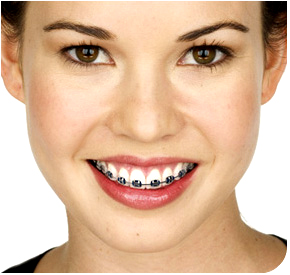 Stages of Orthodontic Treatment: Stages of Orthodontic Treatment:
The orthodontist will first assess the patient and may request extraction of some teeth, usually the second molars. Your regular dentist will usually carry out this procedure.
The first appliance or arch wires:
This will make gross(large) movements of the teeth to get them roughly into the right position. This may take upto 1 year to complete.
Fine Tuning:
A further archwire may be needed to make fine adjustments to the teeth to get them lined up nicely. This may take several more months.
Retention:
The gums take longer to redevelop than does the bone, this can keep the teeth in tension as small elastic band like tissues attach the gum to the tooth. These pull on the tooth and may make it move back slightly to its original position. A wire or plastic appliance can be used which holds the teeth in the same position for six months in order to lessen the chance of a relapse.
Thumb Sucking:
When a child sucks their thumb at night several effects can be produced on the mouth and teeth. The upper incisors may not erupt fully and the line may curve upwards where the thumb sits. The other effect is that thumb suckers have high palates, this can complicate denture construction at a much later age. If the child is only young, then it will probulary correct itself if the child stops sucking their thumb. If the patient is still sucking their thumb when they are in the teenage years then orthodontics will probulary be required. |
| |
| |
| |
|
 |
Smile Designing: |
|
A smile is something that bridges the large gap between any two individuals. In fact a pretty smile can disarm the strongest of opponents in any argument. The teeth play a very important role in creating a perfect smile. It is necessary to have good set of teeth and to be in harmony with the face, the lip line, the curvature of the mouth, etc. The same size and shape of teeth in one smile would look very aesthetic, while in another, they would not. Dentistry is able to alter, reorganize and reposition teeth and the tooth structure can be altered in terms of color, position size and texture without any harmful effects and make it look, feel and behave in the same fashion as natural teeth.
The human body is given a set of 32 teeth of which 28 are the most important working teeth. The four third molars, more commonly known as the wisdom teeth 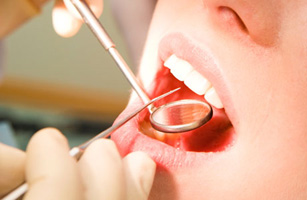 can be discounted. When a person smiles, the teeth are seen in what is called as a “Smile Window”. These are the front 6 to 10 teeth which are also known as the anterior teeth. These comprise of one pair of central incisors, lateral incisors, canines and two pairs of premolars. The smile window displays these teeth with the upper teeth generally covering about 2/3rd of the lower teeth. In order for your smile to be appealing and aesthetic, the teeth have to be in the right proportion and correctly aligned. They need to be of the right shape and color in harmony with the rest of the face. can be discounted. When a person smiles, the teeth are seen in what is called as a “Smile Window”. These are the front 6 to 10 teeth which are also known as the anterior teeth. These comprise of one pair of central incisors, lateral incisors, canines and two pairs of premolars. The smile window displays these teeth with the upper teeth generally covering about 2/3rd of the lower teeth. In order for your smile to be appealing and aesthetic, the teeth have to be in the right proportion and correctly aligned. They need to be of the right shape and color in harmony with the rest of the face.
The factors that mainly influence smile design are
- Your facial shape. For example, a long face may need to accentuate width to appear more oval. Someone with attractive features in the center of the face may need bold central incisors to draw attention to that center
- Your image aspirations. How do you want to appear to others? A sophisticated smile gives the appearance of more intelligence, maturity and judgment. A sexy smile gives the appearance of more warmth, energy and boldness
- Your age, or how old you want to appear. Longer central incisors make you appear younger. Also, whiter teeth make you appear younger. Conversely, a flatter smile or a more subdued color to the teeth make you appear more mature
Along with the teeth, the gums, technically known as the gingiva also play a significant role. There is certain proportion of pink to white, which has to be maintained for the smile to be pleasing and beautiful. At times, the only difference between an excellent smile and a run of the mill smile can be heavily pigmented gums. If there is discrepancy in any of the above listed factors, the smile tends to get unaesthetic. It is not that if any one of the above conditions is not met, the looks will be totally hampered. Many a time, totally out of position teeth or disproportionate teeth may still exhibit a very pleasing smile. When the smile does get unaesthetic, the dentist can play a large role in correcting these discrepancies. |
| |
| |
| |
|
 |
Dental Jewellery: |
|
Teeth jewellery is a brilliant way to add sparkles to your smile and stand out of the crowd.
Teeth jewellery (skyce) offered at our clinic is made and certified in the EU, and is available in two colours: "crystal" and "sapphire 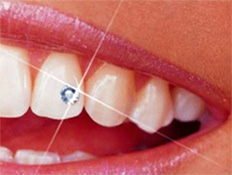 blue". During a painless procedure, a dentist fixes a jewel on the tooth surface. The jewel does not damage tooth tissues and has no side effects – except for the increased charm of your smile! Call it an oral fashion statement to stand out among ordinary mortals or simply an effort to blend in with the bold and the beautiful. blue". During a painless procedure, a dentist fixes a jewel on the tooth surface. The jewel does not damage tooth tissues and has no side effects – except for the increased charm of your smile! Call it an oral fashion statement to stand out among ordinary mortals or simply an effort to blend in with the bold and the beautiful.
Skyce is putting an extra sparkle into more and more smiles. Skyce jewels are applied to the labial surfaces of upper anterior teeth.
The trend is catching up with males, especially those heading towards foreign destinations for study or leisure. However, not many girls are visiting clinics and enquiring about tooth jewellery. But it is only a matter of time before "Skyce" acquires universal appeal.
If somebody thinks he or she was better off without tooth jewellery, it can be easily removed without any side effects on the dental tooth structure as the procedure is non-invasive. What's more, tooth jewellery can be fixed again at a later stage. |
| |
| |
| |
|
 |
Teeth Whitening: |
|
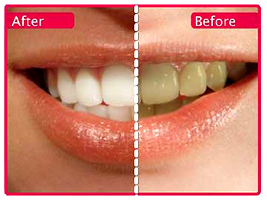 Teeth whitening have become so popular that it seems like everyone is doing it. If you want to obtain a bright and white smile, teeth whitening may be just what you are looking for. Not only is teeth whitening effective, it can also drastically change your smile and improve your self-esteem at the same time. Before you consider undergoing a teeth whitening procedure, it is a good idea to understand what causes yellow teeth in the first place. There are many factors that affect the color of your teeth. These teeth whitening techniques and methods are intended to boost the luster of one’s teeth. Years of smoking, drinking coffee, tea and colas, and even eating highly pigmented foods can wreak havoc on your teeth, turning them dingy and yellow. Even if you are careful to brush your teeth after every meal, aging will cause your teeth to grow dull. Medications can also take away the sparkle in your teeth, causing you to look older than you really are. Teeth whitening have become so popular that it seems like everyone is doing it. If you want to obtain a bright and white smile, teeth whitening may be just what you are looking for. Not only is teeth whitening effective, it can also drastically change your smile and improve your self-esteem at the same time. Before you consider undergoing a teeth whitening procedure, it is a good idea to understand what causes yellow teeth in the first place. There are many factors that affect the color of your teeth. These teeth whitening techniques and methods are intended to boost the luster of one’s teeth. Years of smoking, drinking coffee, tea and colas, and even eating highly pigmented foods can wreak havoc on your teeth, turning them dingy and yellow. Even if you are careful to brush your teeth after every meal, aging will cause your teeth to grow dull. Medications can also take away the sparkle in your teeth, causing you to look older than you really are.
|
| |
| |
| |
|
 |
Valplast Flexible Denture: |
|
 Valplast flexible partial dentures are a new innovation in the field of dentistry. The denture base material used is flexible and is claimed to be a virtually unbreakable material by the manufacturers. Being fleible allows the denture to avoid transferring stresses on to the adjacent teeth and tissues thus minimizing the trauma of having a partial denture. he color of the denture base matches with the oral tissues to perfection and eliminates the use of metal clasps as in other partial dentures. It takes a week and two to three visits to complete the procedure. Valplast flexible partial dentures are a new innovation in the field of dentistry. The denture base material used is flexible and is claimed to be a virtually unbreakable material by the manufacturers. Being fleible allows the denture to avoid transferring stresses on to the adjacent teeth and tissues thus minimizing the trauma of having a partial denture. he color of the denture base matches with the oral tissues to perfection and eliminates the use of metal clasps as in other partial dentures. It takes a week and two to three visits to complete the procedure.
|
| |
| |
|
|
|
 Although you don't necessarily need to brush them yet, you should start cleaning your infant's teeth as soon as he gets his first tooth. At first, you can just use a wash cloth to clean your infant's teeth. As he gets more, you can use a soft children's toothbrush.
Although you don't necessarily need to brush them yet, you should start cleaning your infant's teeth as soon as he gets his first tooth. At first, you can just use a wash cloth to clean your infant's teeth. As he gets more, you can use a soft children's toothbrush. Water filters are a special concern, because some of them do filter out fluoride. Counter top filters and the pitcher type filters usually don't remove fluoride, but more sophisticated, point of use filters can. If in doubt, check with the manufacturer to see if the filter removes fluoride.
Water filters are a special concern, because some of them do filter out fluoride. Counter top filters and the pitcher type filters usually don't remove fluoride, but more sophisticated, point of use filters can. If in doubt, check with the manufacturer to see if the filter removes fluoride.




 Cosmetic dentistry (smile makeovers) is the most dramatic, safest and permanent way of improving your smile and overall face structure. The effects of a smile makeover are seen way beyond teeth or the smile. It is the surest, easiest and quickest way to enhance your personality and self esteem. Cosmetic dentistry is much more than a smile makeover, it is a confidence makeover.
Cosmetic dentistry (smile makeovers) is the most dramatic, safest and permanent way of improving your smile and overall face structure. The effects of a smile makeover are seen way beyond teeth or the smile. It is the surest, easiest and quickest way to enhance your personality and self esteem. Cosmetic dentistry is much more than a smile makeover, it is a confidence makeover.
 Crowns may be made from several different materials, gold and porcelain being the most common types.
Crowns may be made from several different materials, gold and porcelain being the most common types. A bridge allows the dentist to replace lost teeth without the use of a denture or dental implant. Basically a false tooth is held in place by being attached to a tooth next door. The disadvantage is that the teeth next to the space have to be prepared in a similiar way to a crown in order to accept the bridge. If these teeth already have crowns or big restorations then this is not a problem, the major concern however is when these teeth have small or no restorations (fillings). One compromise is the 'acid etched bridge', with this type a fine ledge is placed on the back of the adjacent teeth.
A bridge allows the dentist to replace lost teeth without the use of a denture or dental implant. Basically a false tooth is held in place by being attached to a tooth next door. The disadvantage is that the teeth next to the space have to be prepared in a similiar way to a crown in order to accept the bridge. If these teeth already have crowns or big restorations then this is not a problem, the major concern however is when these teeth have small or no restorations (fillings). One compromise is the 'acid etched bridge', with this type a fine ledge is placed on the back of the adjacent teeth.
 condition - periodontitis - that damages the gums and bone surrounding the teeth.
condition - periodontitis - that damages the gums and bone surrounding the teeth. A dental implant is an artificial tooth root that a periodontist places into your jaw to hold a replacement tooth or bridge. Dental implants are an ideal option for people in good general oral health who have lost a tooth or teeth due to periodontal disease, an injury, or some other reason.
A dental implant is an artificial tooth root that a periodontist places into your jaw to hold a replacement tooth or bridge. Dental implants are an ideal option for people in good general oral health who have lost a tooth or teeth due to periodontal disease, an injury, or some other reason.
 can be discounted. When a person smiles, the teeth are seen in what is called as a “Smile Window”. These are the front 6 to 10 teeth which are also known as the anterior teeth. These comprise of one pair of central incisors, lateral incisors, canines and two pairs of premolars. The smile window displays these teeth with the upper teeth generally covering about 2/3rd of the lower teeth. In order for your smile to be appealing and aesthetic, the teeth have to be in the right proportion and correctly aligned. They need to be of the right shape and color in harmony with the rest of the face.
can be discounted. When a person smiles, the teeth are seen in what is called as a “Smile Window”. These are the front 6 to 10 teeth which are also known as the anterior teeth. These comprise of one pair of central incisors, lateral incisors, canines and two pairs of premolars. The smile window displays these teeth with the upper teeth generally covering about 2/3rd of the lower teeth. In order for your smile to be appealing and aesthetic, the teeth have to be in the right proportion and correctly aligned. They need to be of the right shape and color in harmony with the rest of the face. blue". During a painless procedure, a dentist fixes a jewel on the tooth surface. The jewel does not damage tooth tissues and has no side effects – except for the increased charm of your smile! Call it an oral fashion statement to stand out among ordinary mortals or simply an effort to blend in with the bold and the beautiful.
blue". During a painless procedure, a dentist fixes a jewel on the tooth surface. The jewel does not damage tooth tissues and has no side effects – except for the increased charm of your smile! Call it an oral fashion statement to stand out among ordinary mortals or simply an effort to blend in with the bold and the beautiful. Teeth whitening have become so popular that it seems like everyone is doing it. If you want to obtain a bright and white smile, teeth whitening may be just what you are looking for. Not only is teeth whitening effective, it can also drastically change your smile and improve your self-esteem at the same time. Before you consider undergoing a teeth whitening procedure, it is a good idea to understand what causes yellow teeth in the first place. There are many factors that affect the color of your teeth. These teeth whitening techniques and methods are intended to boost the luster of one’s teeth. Years of smoking, drinking coffee, tea and colas, and even eating highly pigmented foods can wreak havoc on your teeth, turning them dingy and yellow. Even if you are careful to brush your teeth after every meal, aging will cause your teeth to grow dull. Medications can also take away the sparkle in your teeth, causing you to look older than you really are.
Teeth whitening have become so popular that it seems like everyone is doing it. If you want to obtain a bright and white smile, teeth whitening may be just what you are looking for. Not only is teeth whitening effective, it can also drastically change your smile and improve your self-esteem at the same time. Before you consider undergoing a teeth whitening procedure, it is a good idea to understand what causes yellow teeth in the first place. There are many factors that affect the color of your teeth. These teeth whitening techniques and methods are intended to boost the luster of one’s teeth. Years of smoking, drinking coffee, tea and colas, and even eating highly pigmented foods can wreak havoc on your teeth, turning them dingy and yellow. Even if you are careful to brush your teeth after every meal, aging will cause your teeth to grow dull. Medications can also take away the sparkle in your teeth, causing you to look older than you really are. Valplast flexible partial dentures are a new innovation in the field of dentistry. The denture base material used is flexible and is claimed to be a virtually unbreakable material by the manufacturers. Being fleible allows the denture to avoid transferring stresses on to the adjacent teeth and tissues thus minimizing the trauma of having a partial denture. he color of the denture base matches with the oral tissues to perfection and eliminates the use of metal clasps as in other partial dentures. It takes a week and two to three visits to complete the procedure.
Valplast flexible partial dentures are a new innovation in the field of dentistry. The denture base material used is flexible and is claimed to be a virtually unbreakable material by the manufacturers. Being fleible allows the denture to avoid transferring stresses on to the adjacent teeth and tissues thus minimizing the trauma of having a partial denture. he color of the denture base matches with the oral tissues to perfection and eliminates the use of metal clasps as in other partial dentures. It takes a week and two to three visits to complete the procedure.